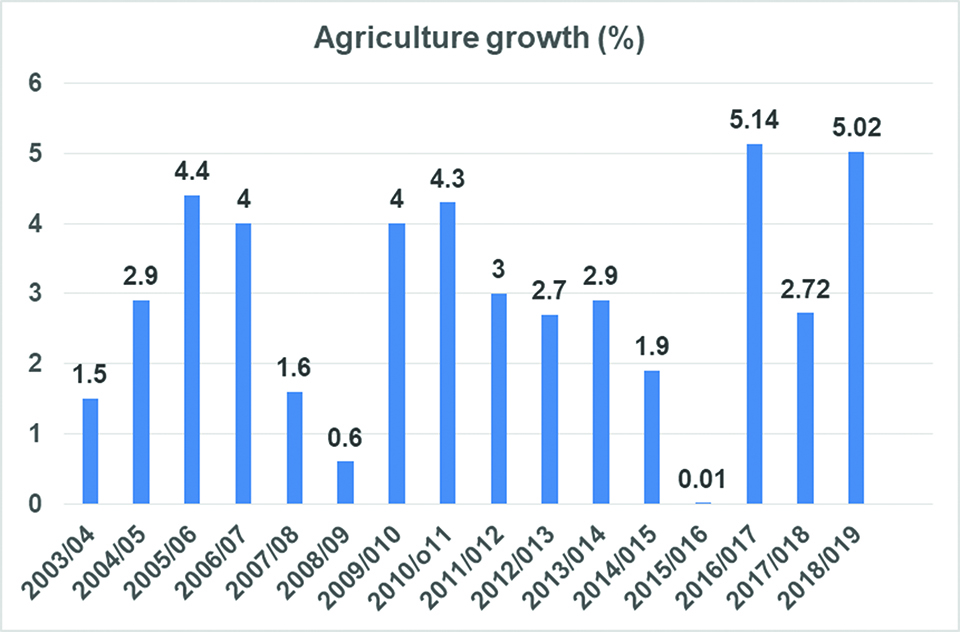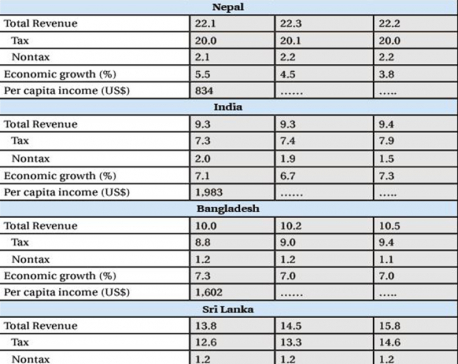
OR
Agriculture Growth

Agriculture in Nepal is suffering from years of under-investment, limited research, scant inputs and lack of technology and services for farmers
Agriculture development is a multi-dimensional initiative and calls for consolidated effort of all stakeholders. Coordination among these stakeholders from grassroots level to the center is essential for the success of the programs but effective coordination mechanisms are missing at present. There is no time-bound implementation plan. There is no program to promote backward and forward linkages in agribusiness sectors. In fact, agriculture in Nepal is suffering from years of under-investment, limited research, scant inputs and lack of technology and services for farmers. Hence, crop yields are just 50 to 60 percent of the achievable yields in the irrigated farms and agriculture growth pattern is erratic. While most development plans gave high priority to agriculture development, government investment in Ministry of Agriculture and Livestock Development (MOALD) has declined from 3.7 percent of all government spending 10 years ago to about 2.3 percent for the next fiscal year.
Many people having interest in agriculture have set their hopes on the effective implementation of Agriculture Development Strategy (ADS) for sustainable agriculture development. It is because sustainable agricultural growth is critical to ensure food and nutrition security in a country like Nepal. The government has executed Prime Minister Agriculture Modernization Project (PMAMP) for the last two years for implementing ADS. The PMAMP has now 2776 pockets, 336 blocks, 69 zones and 14 super zones across the country. These pockets, blocks, zones and super zones are envisaged for commercializing agriculture by addressing the issues of land fragmentation, low use of modern technology and weak coordination. But none of these issues has been addressed so far. The project is reported to be inefficient in resource utilization. Even then, the budget has been increased to Rs 8.10 billion for the fiscal year 2019-2020.
Monsoon dependence
According to the economic survey of 2075-76 (BS), the growth of agriculture for the 2075-76 (BS) is estimated to be about 5.1 percent. The agricultural growth for the fiscal year 2074-75 (BS) was 2.7 percent. Furthermore, the average agricultural growth for the last two decades was 3.2 percent. Production and productivity of rice for this year is estimated to be increased by 8.9 and 7.3 percent respectively. Similarly maize production and productivity for the same fiscal has increased by 3.5 and 4.8 percent. Wheat production and productivity is expected to increase by 4.5 and 7.6 percent. These three are the main food crops grown in Nepal. Vegetable production has also been reported to be increased by 1.86 percent.
The contributing factors for such increased production and productivity are reported as (1) improvement in supply of production inputs; (2) increase in irrigated areas; and (3) favorable weather conditions. Regarding production inputs, fertilizers and seeds are the main contributing inputs for increasing production. But the sale of fertilizers for the first eight months of FY 2075-76 was only 192 thousand ton. The sale of fertilizers for the same period was 204 thousand ton. This clearly indicates that fertilizer supply has not been improved.
The improvement in the use of improved seeds for FY 2075-76 is even worse. Let us take the example of source seed production. The total source seed production of rice, maize, wheat, buckwheat, millet, barley, potato, pulses, vegetables etc during the first eight months of FY 2075-76 was 192.69 tons. Whereas the production of source seed for these crops during the same period of was 277.38 tons. Not only the quantity, the quality of seed is also questionable. Farmers are demanding hybrid seed but their production is far below the demand.
Regarding irrigation, the reported figure of additional irrigated areas for FY 2075-76 is 3210 hectares. But there is no improvement in the efficiency of irrigation. Only 33 percent of the total irrigated areas is irrigated all the year round. All these facts indicate that the main contributing factor for increased production for this FY is the favorable weather condition. It means Nepali agriculture is still heavily dependent on monsoon rain. The growth patterns shown in the table indicates the same.
Ineffective services
Extension services are not delivered effectively due to restructuring of agriculture and lack of staffing at the local level. Agricultural development programs are to be carried out at provincial and local levels but the organizational structure is centralized. With such structure, the provincial and local governments will not be able to provide farmers with the services they need. Needless to say, one of the objectives of local level restructuring in agriculture is to provide effective services to the farmers. To meet this objective, we need one to three Community Agricultural Service Centers (CASCs) in each local unit as proposed by the Agriculture Development Strategy (ADS). These CASCs should be well equipped with necessary facilities and provided with adequate number of technical staffs. But the government has proposed to deploy one technician to each local level.
Inputs needed to increase the land’s productivity—from seed, to fertilizer, machinery, irrigation, and finance—are scarce. Farmers hardly get compensation when their crops fail. Every year, thousands of youths, especially from rural areas, are migrating abroad for employment, leaving mostly women, children and the elderly behind. Female-headed agricultural households have increased from 12 percent in 1995 to more than 30 percent as of now. Mechanization of agriculture is at preliminary stage. Only seven percent of households own a pump (not taking into account whether or not that pump actually works), and a mere one percent own tractors, power tillers, or threshers. People are leaving land fallow where crops worth millions of rupees would have been produced.
The coming years may be bleak for agriculture if irrigation system is not improved for reliable water supply in crop fields. Though the budget has proposed to provide all-the-year round irrigation to all super-zones, zones, blocks and pockets within the coming fiscal, practically it is not possible. Furthermore, an early forecast has shown a below-average monsoon in key crop-producing areas of the country. It means agricultural output growth, the key sector for economic growth, may be low in the coming fiscal year.
But rebuilding of Nepal is not possible without improving agriculture in a sustainable way. Therefore, the government should have strong commitment to developing sustainable agriculture by making irrigation reliable and improving input supply system. Programs should also be geared toward tailoring location specific farming systems.
bhairabr@gmail.com
You May Like This

Are we a peaceful nation?
Based on Nepal’s happiness index, Nepal is a happy country because we do not have violence but we are also... Read More...

Tax exploitation in Nepal
High taxation policy pursued by Nepal has worked as a powerful drag on the economy by hurting private sector incentive... Read More...

Drifts on foreign policy
Diplomacy and development have been conducted in an ad hoc manner based more on sporadic “big dream talks” than a... Read More...







Just In
- NRB to provide collateral-free loans to foreign employment seekers
- NEB to publish Grade 12 results next week
- Body handover begins; Relatives remain dissatisfied with insurance, compensation amount
- NC defers its plan to join Koshi govt
- NRB to review microfinance loan interest rate
- 134 dead in floods and landslides since onset of monsoon this year
- Mahakali Irrigation Project sees only 22 percent physical progress in 18 years
- Singapore now holds world's most powerful passport; Nepal stays at 98th












Leave A Comment